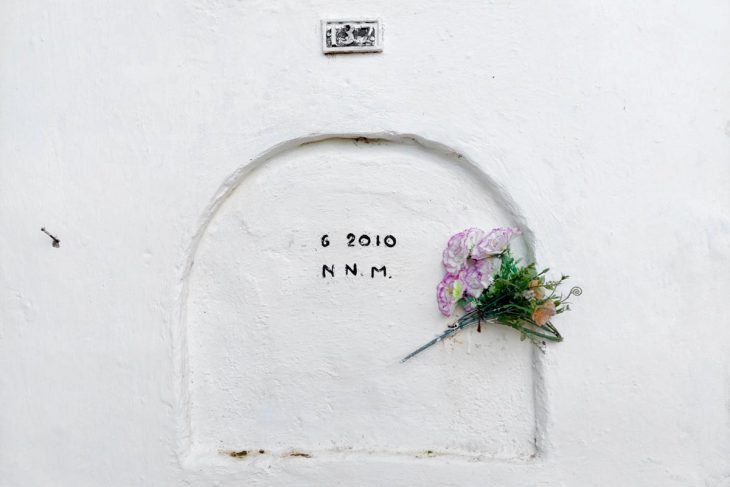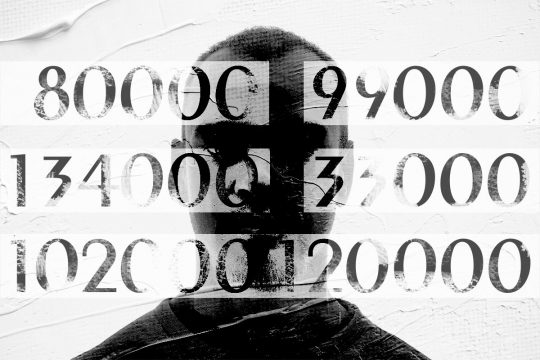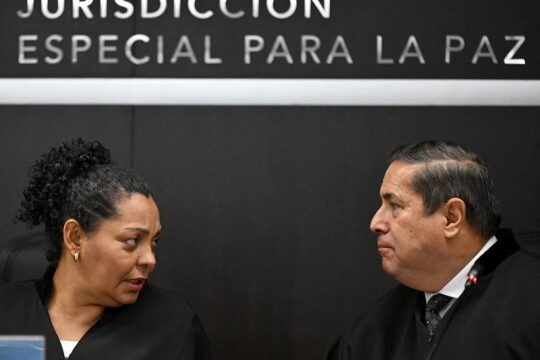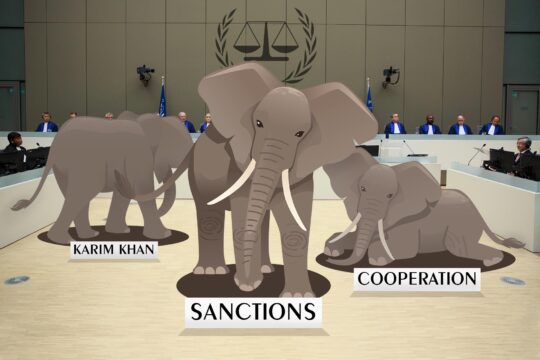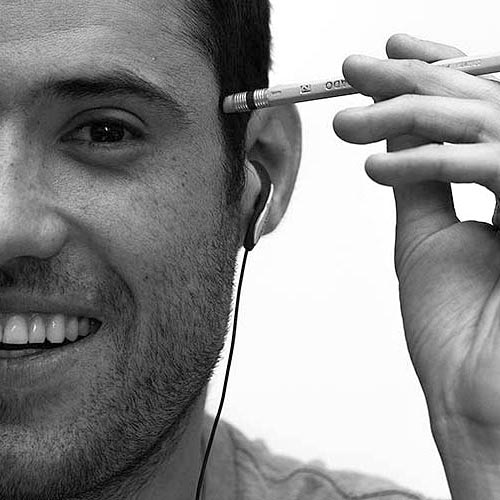“Mother, some boys came to talk to Natalia and took her away,” one of Arnobia Gutiérrez’s four children told her on 23 October 2001, when she returned to her home in the Belencito Corazón neighbourhood, at the top of the Comuna 13 that stretches along the western slopes of Medellín.
In the days that followed, Arnobia discovered that 24 teenagers, including her daughter Natalia Andrea Cartagena, had been recruited that same day by urban militias of the National Liberation Army (ELN), a Colombian guerrilla group. They were apparently taken to a house in a nearby neighbourhood and, in the early hours of the morning, driven in a truck to the rugged mountains of eastern Antioquia, where the ELN had a base of operations. Natalia was 16 years old. She never reappeared.
That was until the Unit for the Search of Disappeared Persons - the smallest and least known body of the transitional justice system created after the 2016 peace agreement with the FARC guerrilla - launched a search process in order to finally give Arnobia an answer.
On October 11th 2021 in Santo Domingo, a mountainous village in northwestern Colombia, when forensic anthropologist Carlos Manuel Bacigalupo held up a blackish necklace, which he had just dusted with his green gloved hands, Arnobia Gutiérrez sighed. It was a scapular with two tear-shaped lockets, their metallic centre surrounded by a plastic coating and held together by three turns of string.
She immediately recognised it.
“I didn't remember, but she never took it off her leg,” she said, serene yet visibly moved, in the recollection of six persons who were by her side that day. In that steep cemetery, a truth that had eluded Arnobia for two decades had finally emerged.
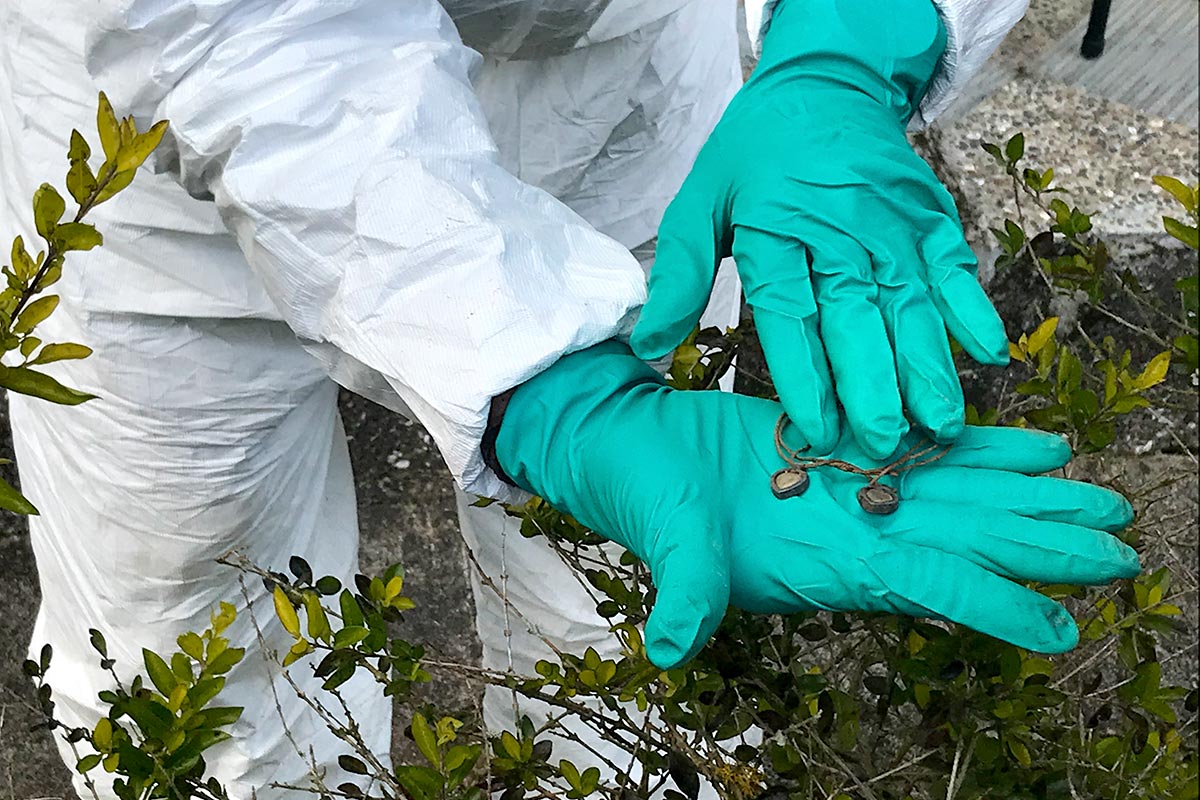
An estimated 99,000 cases of forced disappearance
Until then, Natalia was one of 23,077 documented cases of forced disappearance in Antioquia and one of 99,000 believed to exist in Colombia, according to figures from the Search Unit. Its director, Luz Marina Monzón, has even spoken of 120,000 disappeared. Even Rodolfo Hernández, the leading candidate for next week’s presidential runoff, has a disappeared daughter, after she was kidnapped in 2004 by the ELN and never heard of again.
The discovery of Natalia’s remains is an illustration of what a transitional justice system like Colombia’s can bring to their citizens on a specific and humane level. Arnobia's search had an added urgency. Since 2016, the 55-year-old woman with wavy hair at the nape of her neck has been suffering from a severe breast cancer that has already metastasised in her aorta artery and, more recently, in her thyroid gland.
“Twenty years in there and still have that scapular wrapped around her ankle, that's God’s miracle. To have her bones appear and for me, as a mother, to feel that they were hers...", she said, completing her sentence with the expression of peace in her face. “I’ve felt a relief in my soul ever since.”
Cycles of violence
Back in 2001, when Natalia was forcibly taken away, it was a complex time in Comuna 13. Members of two guerrillas and the paramilitaries fought for control of neighbourhoods, confining frightened residents and setting the pace of daily life. But violence also nested at home: Natalia grew up watching her father, often drunk, beat Arnobia and spend what she’d earned cleaning and cooking in family homes. Over the years, she became less and less tolerant of such abuse and more inclined to confront him. “On a not so distant day, I'm going to leave,” Natalia announced to them one day, weary of that domestic hell. Arnobia believes that this context of gender-based violence and her strained relationship with her father made her vulnerable to the deceitful offers of those who persuaded her to join the guerrilla, even as a child, in an example of how some forms of violence easily lead to others.
Ironically, Arnobia - who eventually ended up filing a complaint against her partner for physical abuse - had married him fleeing another cycle of violence, after her stepfather, upon the death of her mother, abandoned her with a neighbour who would beat her. After Natalia's disappearance, the circle of tragedies continued to pile up on her family: a year later, her husband was murdered and, four years later, her eldest son.
For more than 15 years, Arnobia mourned Natalia in private. But in 2016, she regained the impetus to look for her. She has divided her time between medical exams and chemotherapy, appointments with her lawyers from the Libertad Legal Corporation and the stall where, when she feels well, she sells traditional sweets near La Aurora, the last station of the Medellín funicular.
“Please allow me to bring you outside”
Six years later, on the cloudy afternoon of October 11th 2021, a group of 14 gathered in the cemetery of Santo Domingo perched atop a hill. A purple ribbon interrupted the passage in the San Lorenzo gallery, the necropolis’s western 'street'. Several forensic technicians from the Search Unit flanked the vaults adorned with silk flowers and centred their attention on one at ground level. It was number 12. 'NN, 19 July 2002', it read tersely.
Across the hedge, amid a geometrically patterned garden, was a table with two candles, a vase with magenta lilies and a photo of Natalia Andrea. A few metres back, next to a stone angel blowing his trumpet towards the sky and surrounded by officials from the Search Unit, Arnobia watched silently. She had never been there, even though a mere 73 kilometres separated her from her home in Comuna 13.
Once the topographer had made the survey plan of the gallery, Bacigalupo - the Search Unit’s forensic chief - took a sledge hammer and cracked the white lime slab. After removing fragments of adobe and mortar, he hunkered down and entered the two-and–a-half-metre deep pit, equipped with his brush and dustpan. The Peruvian expert - bundled up in his full-length padded suit, like a sweaty astronaut – remained absent for several minutes. Inside the vault, he noticed that the coffin was almost entirely disintegrated except for some fragments of metal and cloth, that there was a lot of sediment - probably due to a visible leak in the back wall - and that humidity was high.
Once he understood the disposition of the body, he asked for permission to remove it following a personal habit he’s had for years. ‘Please allow me to bring you outside, your mother is there waiting for you', he whispered with a mixture of respect and affection. After adopting a plank position, his back against the ceiling and his elbows against the walls for stability, he went about removing the dirt surrounding Natalia’s body and cleaning each of her bones with infinite gentleness.
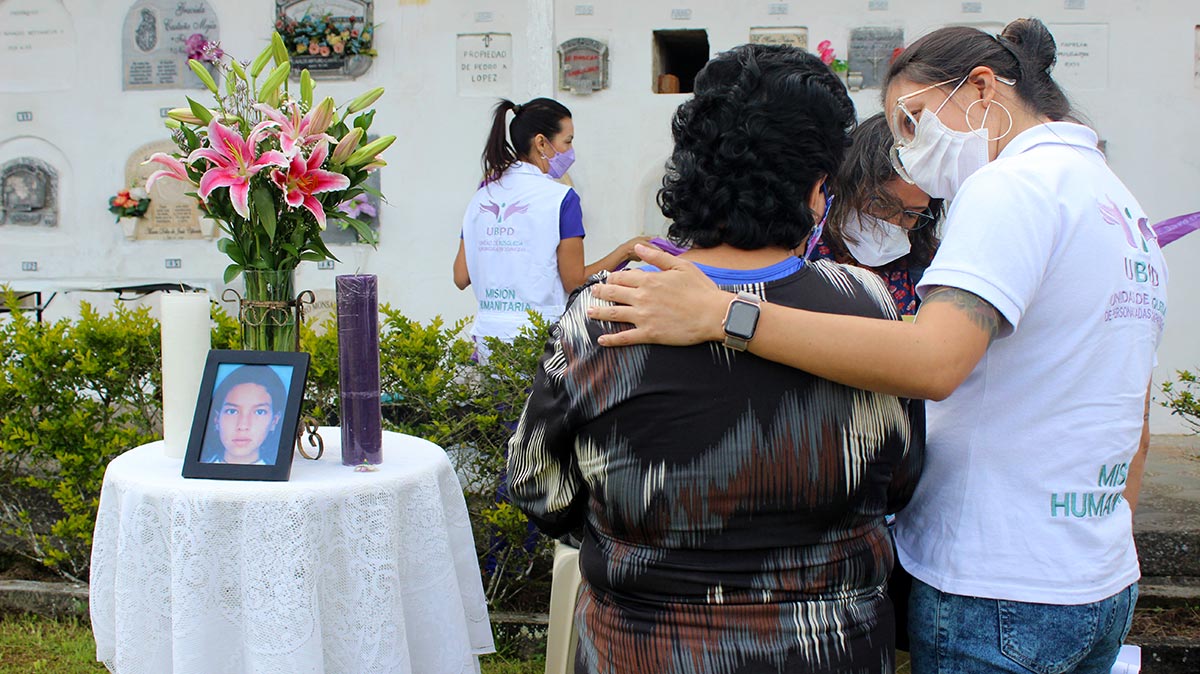
“It’s such a beautiful science”
The anthropologist re-emerged after what Arnobia felt like a short wait. He carefully placed several bone fragments on a folding table. One by one he showed them the bones, telling them which part they belonged to and pointing them out on his own body. “This is the tibia, the long bone of the leg. This is the patella, which is the part here of my knee. Here is the pelvis, which shows that this is a woman,” he explained, arranging them in anatomical position. He re-entered the tomb to then come out in reverse with new bones, repeating the procedure about five times. A forensic photographer recorded every step.
Suddenly, Bacigalupo - married to a Colombian forensic anthropologist whom he met working in Bosnia - held up a dark-coloured object. It was the scapular that Arnobia had forgotten about, but which dispelled her anguish. Memories began to flood back. That it said 'peace and love' on one side. That on the other was a picture of the Sacred Heart, already erased by humidity. That Natalia used to cry when she took a bath and couldn't find it.
“When I saw it, I thought, 'This is my girl'," she recalls, her brown eyes gaining an unusual sparkle, and her face a smile it didn't have before.
A second climax of emotion came when the skull appeared with her brown hair almost intact, something that forensics said is unusual after so many years of burial. “Blondish but thick like a cord”, she’d say. “What they do seemed so beautiful to me. To take out a body in little bones and assemble the skeleton as one's body is, to know which one is the knee and so on with each one. And then to take it apart bone by bone and pack it in little bags”, says Arnobia with awe, emphasising each diminutive.
“It’s such a beautiful science.”
Hypotheses to solve a mystery
At its core, the process of searching for a missing person is an investigation focused on answering three main questions: who are they looking for, what may have happened to them and where did it occur?
In an initial phase, investigators collect any data they can to glean who the person is. Through conversations with family members and acquaintances, and even former combatants of armed groups or victims who have crossed paths with them, they document what clothes or accessories they used to wear, whether they had tattoos or scars or illnesses, whether they were a kidnap victim who never returned home, or a soldier, guerrilla or paramilitary whose trail was lost.
This information, which they contrast with other sources, allows them to build a preliminary dossier that guides the inquiry and which they call 'ante-mortem' - or 'prior to death' – even though one of the paradigms of the search for disappeared persons is that they are presumed to be alive until proven otherwise. Testimony about a person's gait may lead forensic experts to understand that they limped and that, perhaps, that trait could be 'seen' in a physical mark on their bones. This is the osteobiography, a technique perfected by the American Clyde Snow, who helped found the Argentine Forensic Anthropology Team and promoted its exhumations in the 1980s after the military dictatorship.
In Natalia's case, the Search Unit's investigators had a rich ante mortem. From a comment made to Arnobia by a neighbour, it was believed that her nom-de-guerre was 'Jimena'. They knew she had a tattoo on her knuckles. Geography was also a clue: testimonies suggested that the ELN had a base of operations in Alejandría, 80 kilometres from Medellín, and that, after a confrontation in which she is thought to have died, her body was taken to Santo Domingo.
This information came from a confusing family account. A year after her daughter vanished, Arnobia received a call from Santo Domingo’s hospital, which she initially mistook for one in Medellín. She recalls being told that there was a young woman's body that could be Natalia's, but those were times of anxiety, shootings and violent military operations in Comuna 13. She was afraid and never went.
This mapping, however, allowed Search Unit officials to focus their questions a couple of decades later on two hypotheses: that the key dates were 2001 to 2002, and that she might be in either Alejandría or Santo Domingo, separated by 20 kilometres of dense forest. In each village there were three places whose doors were worth knocking on for the records they could keep: the parish, the hospital and the police inspection.
They started by sending letters to Alejandría in mid-2021. To the parish, which usually manages the local cemetery, they asked: Do you have an unidentified body of a young woman buried there, from 2001 or 2002? No, nothing. To the hospital, did they have a necropsy matching that description and those dates? No, they didn't. To the police, did they have a coroner’s report of the sort? Again nothing.
So their attention veered to Santo Domingo. The parish responded almost immediately.
“Yes, we have two,” they wrote. The hospital followed: they also had a couple of autopsies.
A search amid shelves and vaults
In August 2021, two anthropologists from the Search Unit travelled to Santo Domingo to dive into the town's archives and test those first promising leads. In the parish office they found a wooden library with dozens of volumes listing, in chronological order, all the births, baptisms, burials and marriages officiated by local priests. So well safeguarded were they that, penned in cursive handwriting and brown ink on crumpled pages, they found accounts of burials made since 1792, two decades before the colony of New Granada declared its independence from Spain.
An entry, in the corner of page 71 of the fifteenth volume on deaths, caught their attention. On 19 July 2002, the neat handwriting indicated, “the corpse of one N.N.”, who had died two days earlier, had been “canonically buried”. Her approximate age was 16 years and the cause of death “violent”, according to the annotation made – “in good faith” – by priest John Jairo Yepes.
The next day, the two anthropologists went to the hospital built around a neo-Gothic brick chapel. In the archive room, rows of cardboard boxes awaited them, housing thousands of medical records that the hospital is in the process of digitising. There they found the autopsy as well as the coroner's report, which is normally preserved by the police inspection but which some cautious clinics – like this one - sometimes keep as copies of their correspondence.
The autopsy revealed new clues: the young woman had been found at El Manejo, a site in the rural hamlet of Pradera, donning a green T-shirt and camouflaged suit. According to the medical document, she had “long brown hair in a braid, thin eyebrows, regular straight nose, delineated lips, regular teeth in both jaws without maintenance, regular nails.”
The Search Unit experts checked these details and the document timeline - the date of presumed death, of the autopsy and of entry to the cemetery - against the ante mortem to see if they matched. The autopsy mentioned a pocket mirror, with the message 'To Jimena' engraved in the reflection. Three fingers on the left hand were tattooed with the letters N, Y and J, coinciding - at least partially - with the vague memory of Arnobia, as well as three other tattoos: the word 'baby', with a flower in the middle, on the back of the same hand and another flower and a T on the right leg.
The features matched, the chronology was plausible. They had, in forensic jargon, 'traceability'. The person in vault number 12 could be Natalia Andrea Cartagena, Arnobia's missing daughter.
Two months later, when the scapular appeared in the exhumation, they already had what the Search Unit calls an 'oriented identity'. One last step was missing: a genetic analysis to confirm with scientific certainty that this was Natalia. Because, as respected Peruvian forensic anthropologist José Pablo Baraybar advises his students, “there is a difference between possibilities and probabilities: everything is possible with God's help, but only science can say what is probable”.
On April 30th, officials from the Search Unit confirmed to Arnobia that the National Institute of Forensic Medicine (NIFM) had established that the DNA of the exhumed remains matched her genetic sample.

Casting a wider net
Arnobia's case opened the possibility of a broader investigation in Santo Domingo, as part of a regional search plan in central Antioquia.
In fact, that initial inquiry yielded a larger universe: they discovered 20 unidentified people buried in the cemetery between 1999 and 2008, two of which were discarded upon knowing that one died of a stroke in a nursing home and another in a traffic accident. The remaining 17 bodies were exhumed and handed over to the NIFM during the same week in October 2021 that Natalia was found. A second identity has already been identified and the Search Unit is talking to the presumed next of kin.
The four cemetery galleries harbour even more mysteries: dozens of tombs with plastic geraniums and inscriptions such as 'John Doe' reveal that more unidentified bodies lie there. In total, there are still 50 people with no known identity buried there, so the Search Unit is working on a second investigation phase with the remaining thirty bodies that were buried in the decade following Natalia's death.
These are discoveries that, in any case, do not occur in a vacuum, but require other institutions
to play their part in helping shed light on what happened.
In Santo Domingo, the discovery would have been more unlikely if Father John Jairo Sierra and his right-hand, Biviana Chaverra, had not made an inventory of the cemetery. A native of the neighbouring town of Girardota, the priest was moved by the horror stories he heard of trucks towing bodies from the river. That concern led him and his assistant to compile a list of all the vaults marked with an 'N.N.'. His first idea had been to find the relatives of the deceased whose names were known but whose graves no one cared for - the 466 “bodies looking for families”, he calls them. But they soon turned their attention to the 51 unidentified bodies, which they believe could be even more if they open the common ossuaries. They wrote to the Attorney General’s Office and the Interior Ministry, but received little response.
It was at that point that the Search Unit contacted them. In the six months since then, Father Sierra has found a new vocation: he now describes himself, with noticeable pride, as a ‘forensic chaplain’. At Arnobia's request he officiated at a mass after Natalia's exhumation and another one a few days later for the remaining 17 bodies. Several village priests have called him for advice on whether they should get involved in this kind of inquiries, or whether they should steer away. “It is a very specific way of contributing to reconciliation and the inner peace of so many persons going through prolonged grief,” he’s told them. He also tells them that he broke with the tradition of calling them “N.N.” - from the Latin ‘nomen nescio’ or ‘name unknown’ - to now call them ‘unidentified persons’, as in the humanitarian world.
Forensic Medicine delays
Despite the peace of mind Arnobia says she’s felt since seeing Natalia's scapular, it took half a year before she received a definitive confirmation of her daughter's identity. Amidst a lack of forensic personnel, a tight budget and an unclear policy of prioritisation over other types of cases, the NIFM - once famous in the entire continent - is struggling to fulfil its tasks in the search process. Without their official response, without the cross-referencing the genetic profiles of exhumed body and their relatives, the searchers of the disappeared remain in a purgatory.
“It shouldn't have taken more than a month. We had a body with many clues and a mother who gave genetic samples. These are cases that, if prioritised, can be solved quickly,” says Adriana Arboleda, a lawyer with the Libertad Legal Corporation, one of Medellín's oldest human rights organisations. It was she who documented Arnobia's case, took it to the Search Unit and asked for a speedier procedure due to Arnobia’s medical urgency.
These timetables are delaying the search process. As of April this year, the Search Unit had recovered 416 bodies, but only nine have DNA confirmations from Forensic Medicine. Some have been in a queue for over a year. It’s one reason why it could take 66 years for all identified missing persons to see any search action, according to a 2021 congressional report.
Even so, by late April the Search Unit had found five people alive and handed over the remains of 142 persons to their families. For each of them, this moment was an answer to a question that had been open for years.
“When we think of peacebuilding, we tend to think of immediate or large events, but we also achieve it through these small deeds - alleviating the suffering, anguish, uncertainty of a person - which is something momentous for them,” says Luz Marina Monzón, the Search
Unit’s director and herself a lawyer who for two decades searched for disappeared persons.
I feel very happy. Seeing the truth is truly a beautiful moment. So many women fighting, so many who have died without knowing the truth, and now as a mother I know this is my daughter’s body.
A wait comes to an end
Arnobia’s quest will finally come to an end shortly when she will receive, in a solemn ceremony, the remains of Natalia. It was originally slated for June 10, but a delay with the death certificate by the Registrar’s Office impeded it.
“I feel very happy. Seeing the truth is truly a beautiful moment. So many women fighting, so many who have died without knowing the truth, and now as a mother I know this is my daughter’s body,” she says. She decided that Natalia shall be buried in a special mausoleum for the disappeared at Medellín’s Universal Cemetery, but will keep her scapular.
In Santo Domingo the vault where Natalia lay for two decades is now covered. Only this time its occupant is no longer an unidentified person, but Evelio Antonio García, a local who died on January 26th.
In February, after a CT scan and biopsy, Arnobia was diagnosed with a new cancerous tumour, this time in her thyroid gland, which at times causes her pain when chewing or swallowing. She is waiting for doctors to tell her if it will require a new surgery, which would be her fourth.
“For me this has been 20 years of struggle, suffering, sadness and pain. Knowing that I found her is a relief. I can now deal with my illness peacefully.”


